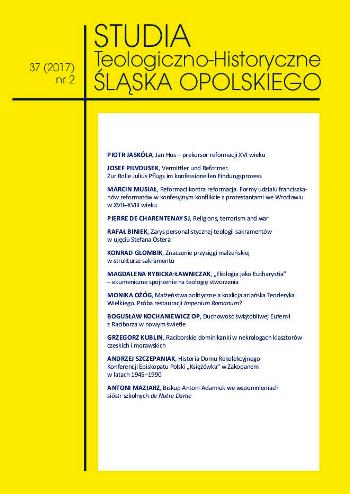Reformaci kontra reformacja Formy udziału franciszkanów reformatów w konfesyjnym konflikcie z protestantami we Wrocławiu w XVII–XVIII wieku
Reformats versus Reformation. Participation forms of the Franciscans Order of Reformats in the denominational conflict with Protestants in Wrocław in XVII–XVIII Century
Author(s): Marcin MusiałSubject(s): Christian Theology and Religion, Politics and religion, State/Government and Education, 17th Century, 18th Century
Published by: Uniwersytet Opolski
Keywords: Silesian Franciscans; Wrocław; St. Anthony’s church; re-catholicization; Reformation;
Summary/Abstract: After 1648 the denominational situation in Silesia, a region which was till 1742 a part of the territories of the House of Habsburg as one of the Kingdom of Bohemia land, was extremely affected by the occurrence of numerous denominational conflicts between outnumbering Protestants and Catholics who found support with the Habsburg’s in power. The orders, restored by a breath of fresh air of the Council of Trent, included the Order of Reformats who were subjected to the religious policy of the House of Habsburg working on the assumption that the consolidation and building of a powerful state under the rule of an enlightened absolute monarch depends on the uniformity of denomination across the country which actually came down to the restoring position of Catholicism before The Reformation. In the second half of the seventeenth century the forced re-catholicization actions involving the persecution of Lutheranism, was replaced by less radical measures, however, carried out consistently. Due to the activity of the congregational orders the denominational conflict became noticeable in the theological, moral, and artistic discourse. Aside from Jesuits the primary role in the propagation of Catholicism as way of rivalry with Protestants was played by the Franciscans Order of Reformats. Their diverse forms of impact, backed by financial and political support coming from the pro-emperor’s Catholic aristocracy, benefited from both strictly scientific developments (achieved by the all-encompassing internal education systems in orders) as well as a wide range of artistic possibilities. An expression of the practical application of these developments is the St. Anthony Church and Monastery in Wrocław. It constitutes an example of the slightly less radical way which Reformats influenced the inhabitants of Wrocław with particular consideration for concepts in the field of art and architecture. As in this case art had served as a perfect instrument for polemic fights between denominations by being a clearly readable means of conveying messages and ideas to promote a new, triumphant Catholic Church.
Journal: Studia Teologiczno-Historyczne Śląska Opolskiego
- Issue Year: 37/2017
- Issue No: 2
- Page Range: 49-64
- Page Count: 16
- Language: Polish

